Marvellous memories maintaining Royal Docks history – as future looks bright
A new online history archive recalling tales of Newham’s history and the characters and events that shaped the Royal Docks of London’s East End has been launched.
London’s Royal Docks have lovingly collected and collated the fascinating collection called Forgotten Stories for this exclusive heritage project from people and families who lived and worked around the docks.
The marvellous project includes conversations that were then filmed and are available to view online, providing a historical record of a unique area of London now on the brink of a major redevelopment.
On Friday, those of us at the launch were privileged enough to meet those who not only told their stories, but those who completed the project including director Iestyn George.
We were then taken on board the Dunkirk Little Ship Silver Queen for a rare chance to tour the Royal Victoria Dock and then to climb in the flights of stairs at the Millennium Mills, which is playing a key role in the regeneration.
And some great new developments were revealed. These include a futuristic one for five years time – a car park for the community underneath the water after the dock is drained!
Coming from North Woolwich and Silvertown and having gone to Drew County Primary School and being a person who has spent over 40 years of my working life in the area, it was a special day for me as well, to see my “manor” in the spotlight.
London’s Royal Docks is now undergoing a major regeneration programme that will transform the area into an innovative new cultural, business and residential district for London.
The Millennium Mills, in Silvertown, is rich in history. Designed and built by millers William Vernon & Sons in 1905, it became famous for its flour girls and rate of flour production. Partially destroyed by the country’s biggest ever explosion, The Silvertown Explosion of 1917 and further bombings during the Second World War, it was rebuilt numerous times and later became home to Spillers Ltd, makers of the famous Winalot dog biscuits. Once abandoned in the early 1980s, the building became famous as the atmospheric backdrop for films music videos.
+ Inside the Mill
The Mills are currently undergoing a major renovation as part of a £3.5 billion redevelopment of Silvertown, to create London’s new Creative Capital. The project aims to create 5m sq. ft. of new business space, 3,000 new homes and more than 20,000 new jobs. As part of this, the building will be restored to retain its art deco frontage, high ceilings and industrial charm to become a hub for business start-ups, innovators and accelerators, setting the tone for the entire development.
+ View from the top of the Mill
Twenty-eight Forgotten Stories, around two minutes long each, have been documented and tell honest, amusing and often shocking tales of a life of genuine hardship, which until now have remained untold.
Pandora George, from Bullet PR said: “Films of the Forgotten Stories are available to view for free at the Forgotten Stories archive.” These can be found at www.londonsroyaldocks.co.uk
This is phase one of an archive, which will continue to grow as more stories are remembered and recorded.
Mike Luddy, Managing Director of RoDMA, the Royal Docks Management Authority said: “The Royal Docks is an incredible feat of engineering with such immense scale and infrastructure. But actually the real story of the docks is about people. It was people who made the docks come alive – thousands of them working here during the docks heyday doing backbreaking work loading and offloading the largest cargo vessels of the day. It was people who lived through the bombardment undertaken by the Luftwaffe during the war. It was people who rebuilt the docks so that they could manage record levels of cargo in the 50s and 60s.”
He went on: “When the docks closed as commercial docks in 1982 nobody could have imagined that some 30 years later there would be a an airport, an International Exhibition Centre (ExCeL) or a university (The University of East London) occupying the areas previously covered in warehousing and cranes.
When we complete the regeneration of the docks with an Asian business park and the redeveloped Silvertown there will be little left of the dock as it once was. However what does remain is the memories of the people who lived and worked here. Our archive of these “forgotten stories” we hope will capture forever the story of the Royal Docks people. Whatever happens in the future it is these people who are the roots of our success.”
Some of the people interviewed for the project include:
Stan Dyson lived at Westward Road, Silvertown and was born in 1945. Stan remembers the Royal Docks on New Year’s Eve, alive to a cacophony of ships hooters, and the smells of Silvertown – from the syrup of Tate and Lyle’s factory to the decaying carcasses of Knight’s bone yard carcass.
Included in his memories were: New Year’s Eve: “At the stroke of midnight every New Year all the ship’s hooters would sound right along the docks for 15 minutes. Some would be high-pitched whistles; some would be low, booming horns. At the same time residents would run into street with a couple of dustbin lids and bang them together, or they’d bash a dustbin lid with a hammer. I think it was to ward off evil spirits, or something. Then someone would run in and out of the houses with a large block of coal, which people thought would bring them good luck for the year ahead. As kids we’d be in the middle of all this noise. It was all very exciting, an unforgettable feeling.”
The smells of Silvertown: “There was a variety of smells in Silvertown – depending where you lived and where you walked, that the smells subtly changed. From Lyle’s factory you had the sweet smell of molasses which was really quite pleasant and as you walked past the shops and you got to the Jubilee public house suddenly wafting over came the smell of Knight’s – John Knight’s bone yard carcasses – that were decaying in huge mounds of sacks. It really stunk.”
+ Stan and Joan Dyson with Colin Grainger
Johnny Ringwood was born in Addison Road, Custom House in 1936. Jimmy remembers growing in the area during World War Two. Included in his memories were:
The bombings of 1944: “I was playing with three of my friends, Jimmy and Davy Lee and a guy called Sparrow. And I had to go home to get my mother some errands, and just as I was at my house going in my front door there was an almighty bang, which blew me up the passage and later I heard that a V2 rocket had landed in exactly the same place, killing all three. Only very young kids. And that hit home because suddenly these were my friends that were no longer there. Whereas before I didn’t really care about bombs but suddenly it became very very personal. There were many many sad personal stories in our area but somehow being, I don’t know, just being cockneys I suppose and being sort of like, you know, roughing it a bit, we put up with it.”
Other memories so far come from George Horncastle, Pat Holland, Jimmy Childs and Joan Dyson. They can all be viewed on the link in this piece. It was so special to see these people together.
The tour of the mill was brilliant, as long as you can climb more than 350 stairs! It gave an insight into how the mill and the surrounding areas may change.
It was also revealed that plans stretch as far ahead as 2020, when it is planned to drain one of the dock locks.
The water is not needed at its current depth. One of the more futuristic plans to help cope with the parking needed for all the new businesses and homes is to drain the dock, build an underwater car park and then put clean and clear water back in on top to a much smaller depth!
I told the bosses they would have a few pieces of contraband, a few UXB’s from the war, and no doubt a few bodies to recover! Imagine the clear up rate for the police. Exciting times ahead for my manor!
+ Putting your shirt – well, hi-fiz jacket in this case…on the future of Silvertown
+ View from the top after 300 stairs. The Thames Barrier and the Thames Barrier Park, which was constructed on one of the country’s most pollute
Pictures: Colin Grainger


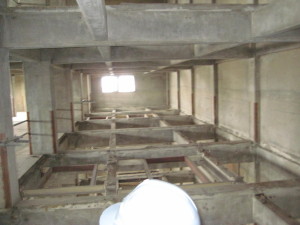
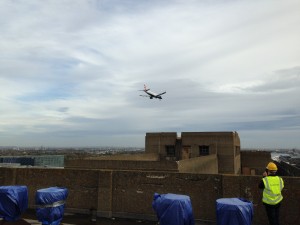
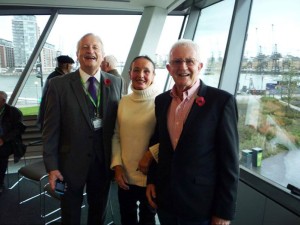
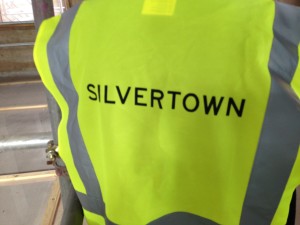
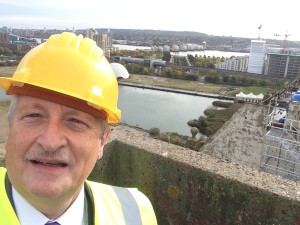
As always Colin a concise and comprehensive report regarding the Forgotten Stories.
Had a ball on Friday, had to miss the Spillers trip, was late back from the BBC interview.
Although I do know the building in its present condition very well, because when I worked for the LDDC, my job to over see the health and safety when they were filming in there which was often.
Try to imagine carrying out health and safety without bloody great holes in the floor.
Happy days (I think)
Regards
Johnny